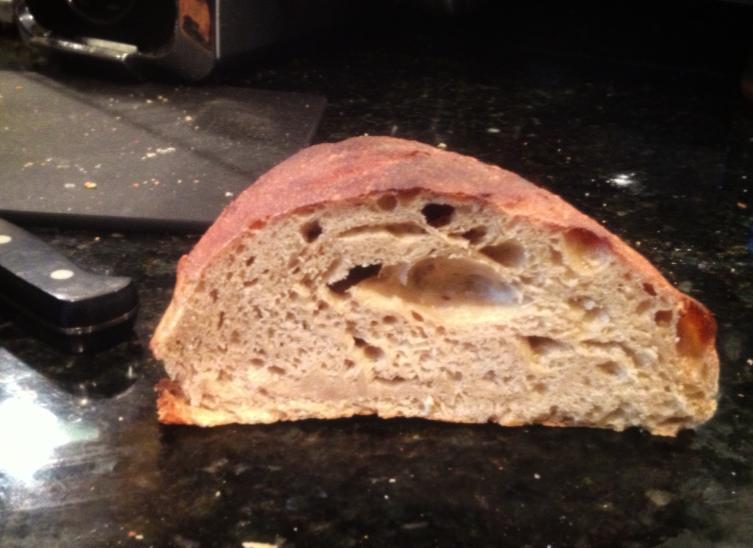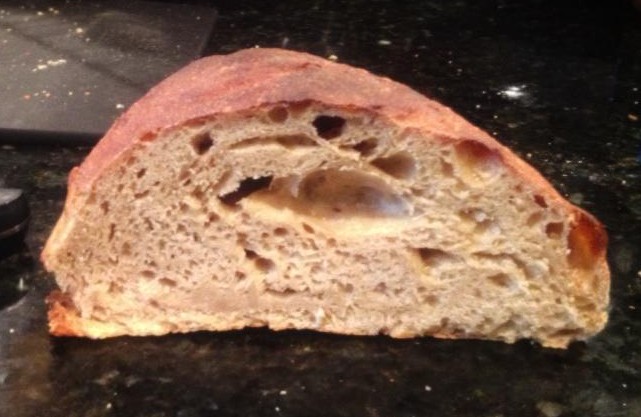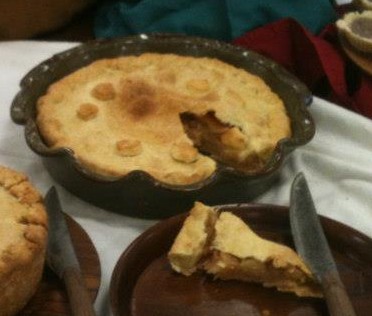What, Where, When:
- Paindemain is a wheat bread, described as being served at the highest tables of the nobility of France and England during the Hundred Years’ War.
- Fine and white, baked in small, round loaves, it was prized for a delicate texture, and considered indulgent enough to be forbidden during Lent in 1417 by Henry V.
Medieval Recipes
There are very few existent bread recipes from pre-1600. Among those are the bread recipe in Platina, the recipe for “Rastons” in one of the Harleian manuscripts, and the recipes for “Fine Manchet” and “Restons” in The Good Huswife’s Handmaide for the Kitchen”.
Platina writes:
“Therefore I recommend to anyone who is a baker that he use flour from wheat meal, well ground and then passed through a fine seive to sift it; then put it in a bread pan with warm water, to which has been added salt, after the manner of the people of Ferrari in Italy. After adding the right amount of leaven, keep it in a damp place if you can and let it rise…. The bread should be well baked in an oven, and not on the same day; bread from fresh flour is most nourishing of all, and should be baked slowly.” (Platina and Milham)
while the recipe for Fine Manchet reads as follows:
“Take two peckes of fine flower, which must be twice boulted, if you will have your manchet verie faire: Then lay it in a place where ye doe use to lay your dowe for your bread, and make a litle hole in it, and put in that water as much leaven as a crab, or a pretie big apple, and as much white salt as will into an Egshell, and all to breake your leven in the water, and put into your flower halfe a pinte of good Ale yest, and so stir this liquor among a litle of your flower, so that ye must make it but thin at the first meeting, and then cover it with flower, and if it be in the winter, ye must keepe it verie warm, and in summer it shall not need so much heate, for in the Winter it will not rise without warmeth.
Thus let it lie two howers and a halfe: then at the second opening take more liquor as ye thinke will serve to wet al the flower. Then put in a pinte and a halfe of good yest, and so all to breake it in short peeces, after yee have well laboured it, and wrought it five or sixe tymes, so that yee bee sure it is throughlie mingled together, so continue labouring it, till it come to a smoothe paste, and be well ware at the second opening that yee put not in too much liquor sodenlie, for then it wil run, and if ye take a litle it will be stiffe, and after the second working it must lie a good quarter of an hower, and keep it warme: then take it up to the moulding board, and with as much speede as is possible to be made, mould it up, and set it into the Oven, of one pecke of flower ye may make ten caste of Manchets faire and good.“ (Recipewise)
Discussion:
This bread is not directly based on either of these bread recipes above. Rather, it is an attempt to make an earlier bread, to resemble that described as served at the highest tables of the nobility of France and England during the Hundred Years’ War. Fine and white, baked in small, round loaves, it was prized for a delicate texture, and considered indulgent enough to be forbidden during Lent in 1417 by Henry V.
“On the 4th February it was ordered that in time of Lent simnel loaves [i. e., loaves of the finest wheaten flour] should not be made, nor yet any other white loaves, that are called painman, maincherin, &c., but only three kinds, namely tourte, bis [brown bread, known also as trete], and white.”
Transactions of the Royal Historical Society, Volume 8 By Royal Historical Society (Great Britain) pp 147-151 quoted in Tudorcook
This bread was also inspired by a note in Peter Brears’ Cooking and Dining in Medieval England, regarding the use of fresh ale yeast in fine breads, to avoid the sourness caused by sourdough (and, as a friend’s experiments have shown, the unpleasant flavors from using “spent” beer barm). As I have a Resident Brewer, this seemed a perfect time to experiment.
Brears writes:
“Since the sourness produced by these methods was unsuitable for the finest white manchets and paindemain, they were replaced by a leaven of the frothy yeast carefully skimmed off the top of ale around the second day of its fermentation … When required, a volume of it equal to one twentieth of the white flour was mixed with salt and warm water, mixed to a batter in the flour in the dough trough, and then processed just like the cheat dough. Having been left to rise, it was moulded into round, flat cakes, their edges cut all the way round, and their centres pricked through. This ensured that they rose vertically, producing a lighter crumb and occupying far less space in the oven.”
Peter Brears (11)
As to the size of the round loaves, this appears to have varied as well, from a conjectural weight of approximately a pound as described by Brears (116) to half that in the time of Queen Elizabeth I. (Wilson 118) I’ve chosen the larger dimension.
Additional Notes:
- While perfectly white flour and thus bread was the goal, medieval bolting techniques were not sufficient to completely remove all of the bran without a prohibitive amount of waste, so in an effort to mimic this flour, I’ve added some whole wheat back to the mix.
- The recipe seems to indicate a large quantity of salt, but with less salt early redactions were very flat-tasting.
- The yeast was skimmed from the top of an actively fermenting batch of English ale, started 2 days before baking. The beer was prepared with an all-grain methodology, and the only significant difference from an ale from the same time as the bread is the (minor) presence of hops.
- The water was actually leftover treated water from the brewing process – my Resident Brewer dechlorinates and remineralizes our local water in order to better support yeast development, and the extra minerals also make the bread taste better. (Think NY Bagels!)
Sources:
1302597
{1302597:QIJBD8AH},{1302597:3ZFT2MDE},{1302597:M27XH4WR},{1302597:HMUATTCX},{1302597:86R342PC},{1302597:U3HAMCHA}
1
modern-language-association
50
creator
asc
626
https://www.erminespot.com/wp-content/plugins/zotpress/
%7B%22status%22%3A%22success%22%2C%22updateneeded%22%3Afalse%2C%22instance%22%3Afalse%2C%22meta%22%3A%7B%22request_last%22%3A0%2C%22request_next%22%3A0%2C%22used_cache%22%3Atrue%7D%2C%22data%22%3A%5B%7B%22key%22%3A%22QIJBD8AH%22%2C%22library%22%3A%7B%22id%22%3A1302597%7D%2C%22meta%22%3A%7B%22creatorSummary%22%3A%22Brears%22%2C%22parsedDate%22%3A%222012%22%2C%22numChildren%22%3A2%7D%2C%22bib%22%3A%22%26lt%3Bdiv%20class%3D%26quot%3Bcsl-bib-body%26quot%3B%20style%3D%26quot%3Bline-height%3A%202%3B%20padding-left%3A%201em%3B%20text-indent%3A-1em%3B%26quot%3B%26gt%3B%5Cn%20%20%26lt%3Bdiv%20class%3D%26quot%3Bcsl-entry%26quot%3B%26gt%3BBrears%2C%20Peter.%20%26lt%3Bi%26gt%3BCooking%20and%20Dining%20in%20Medieval%20England%26lt%3B%5C%2Fi%26gt%3B.%20Prospect%20Books%2C%202012.%26lt%3B%5C%2Fdiv%26gt%3B%5Cn%26lt%3B%5C%2Fdiv%26gt%3B%22%2C%22data%22%3A%7B%22itemType%22%3A%22book%22%2C%22title%22%3A%22Cooking%20and%20Dining%20in%20Medieval%20England%22%2C%22creators%22%3A%5B%7B%22creatorType%22%3A%22author%22%2C%22firstName%22%3A%22Peter%22%2C%22lastName%22%3A%22Brears%22%7D%5D%2C%22abstractNote%22%3A%22%5Cu5468%5Cu6520%5Cu6869%5Cu7374%5Cu6f72%5Cu7920%5Cu6f66%5Cu206d%5Cu6564%5Cu6965%5Cu7661%5Cu6c20%5Cu666f%5Cu6f64%5Cu2061%5Cu6e64%5Cu2063%5Cu6f6f%5Cu6b65%5Cu7279%5Cu2068%5Cu6173%5Cu2072%5Cu6563%5Cu6569%5Cu7665%5Cu6420%5Cu6120%5Cu6661%5Cu6972%5Cu2061%5Cu6d6f%5Cu756e%5Cu7420%5Cu6f66%5Cu2061%5Cu7474%5Cu656e%5Cu7469%5Cu6f6e%5Cu2066%5Cu726f%5Cu6d20%5Cu7468%5Cu6520%5Cu706f%5Cu696e%5Cu7420%5Cu6f66%5Cu2076%5Cu6965%5Cu7720%5Cu6f66%5Cu2072%5Cu6563%5Cu6970%5Cu6573%5Cu2028%5Cu6f66%5Cu2077%5Cu6869%5Cu6368%5Cu206d%5Cu616e%5Cu7920%5Cu7375%5Cu7276%5Cu6976%5Cu6529%5Cu2061%5Cu6e64%5Cu206f%5Cu6620%5Cu7468%5Cu6520%5Cu6765%5Cu6e65%5Cu7261%5Cu6c20%5Cu636f%5Cu6e74%5Cu6578%5Cu7420%5Cu6f66%5Cu2066%5Cu6561%5Cu7374%5Cu7320%5Cu616e%5Cu6420%5Cu6665%5Cu6173%5Cu7469%5Cu6e67%5Cu2e20%5Cu4974%5Cu2068%5Cu6173%5Cu206e%5Cu6576%5Cu6572%5Cu2c20%5Cu6173%5Cu2079%5Cu6574%5Cu2c20%5Cu6265%5Cu656e%5Cu2073%5Cu7475%5Cu6469%5Cu6564%5Cu2077%5Cu6974%5Cu6820%5Cu616e%5Cu2065%5Cu7965%5Cu2074%5Cu6f20%5Cu7468%5Cu6520%5Cu7265%5Cu616c%5Cu206d%5Cu6563%5Cu6861%5Cu6e69%5Cu6373%5Cu206f%5Cu6620%5Cu666f%5Cu6f64%5Cu2070%5Cu726f%5Cu6475%5Cu6374%5Cu696f%5Cu6e20%5Cu616e%5Cu6420%5Cu7365%5Cu7276%5Cu6963%5Cu653a%5Cu2074%5Cu6865%5Cu2065%5Cu7175%5Cu6970%5Cu6d65%5Cu6e74%5Cu2075%5Cu7365%5Cu642c%5Cu2074%5Cu6865%5Cu2068%5Cu6f75%5Cu7365%5Cu686f%5Cu6c64%5Cu206f%5Cu7267%5Cu616e%5Cu6973%5Cu6174%5Cu696f%5Cu6e2c%5Cu2074%5Cu6865%5Cu2061%5Cu7263%5Cu6869%5Cu7465%5Cu6374%5Cu7572%5Cu616c%5Cu2061%5Cu7272%5Cu616e%5Cu6765%5Cu6d65%5Cu6e74%5Cu7320%5Cu666f%5Cu7220%5Cu6b69%5Cu7463%5Cu6865%5Cu6e73%5Cu2c20%5Cu7374%5Cu6f72%5Cu652d%5Cu726f%5Cu6f6d%5Cu732c%5Cu2070%5Cu616e%5Cu7472%5Cu6965%5Cu732c%5Cu206c%5Cu6172%5Cu6465%5Cu7273%5Cu2c20%5Cu6365%5Cu6c6c%5Cu6172%5Cu732c%5Cu2061%5Cu6e64%5Cu2064%5Cu6f6d%5Cu6573%5Cu7469%5Cu6320%5Cu6164%5Cu6d69%5Cu6e69%5Cu7374%5Cu7261%5Cu7469%5Cu6f6e%5Cu2e20%5Cu5468%5Cu6973%5Cu206e%5Cu6577%5Cu2077%5Cu6f72%5Cu6b20%5Cu6279%5Cu2050%5Cu6574%5Cu6572%5Cu2042%5Cu7265%5Cu6172%5Cu732c%5Cu2070%5Cu6572%5Cu6861%5Cu7073%5Cu2042%5Cu7269%5Cu7461%5Cu696e%5Cu2773%5Cu2066%5Cu6f72%5Cu656d%5Cu6f73%5Cu7420%5Cu6578%5Cu7065%5Cu7274%5Cu206f%5Cu6e20%5Cu7468%5Cu6520%5Cu6869%5Cu7374%5Cu6f72%5Cu6963%5Cu616c%5Cu206b%5Cu6974%5Cu6368%5Cu656e%5Cu2c20%5Cu6c6f%5Cu6f6b%5Cu7320%5Cu6174%5Cu2074%5Cu6865%5Cu7365%5Cu2069%5Cu6d70%5Cu6f72%5Cu7461%5Cu6e74%5Cu2065%5Cu6c65%5Cu6d65%5Cu6e74%5Cu7320%5Cu6f66%5Cu2063%5Cu6f6f%5Cu6b69%5Cu6e67%5Cu2061%5Cu6e64%5Cu2064%5Cu696e%5Cu696e%5Cu672e%5Cu2048%5Cu6520%5Cu616c%5Cu736f%5Cu2073%5Cu7562%5Cu6a65%5Cu6374%5Cu7320%5Cu7468%5Cu6520%5Cu6d61%5Cu6e79%5Cu2073%5Cu7572%5Cu7669%5Cu7669%5Cu6e67%5Cu2064%5Cu6f63%5Cu756d%5Cu656e%5Cu7473%5Cu2072%5Cu656c%5Cu6174%5Cu696e%5Cu6720%5Cu746f%5Cu2066%5Cu6f6f%5Cu6420%5Cu7365%5Cu7276%5Cu6963%5Cu6520%5Cu2d20%5Cu686f%5Cu7573%5Cu6568%5Cu6f6c%5Cu6420%5Cu6f72%5Cu6469%5Cu6e61%5Cu6e63%5Cu6573%5Cu2c20%5Cu7265%5Cu6775%5Cu6c61%5Cu7469%5Cu6f6e%5Cu7320%5Cu616e%5Cu6420%5Cu636f%5Cu6d6d%5Cu656e%5Cu7461%5Cu7269%5Cu6573%5Cu202d%5Cu2074%5Cu6f20%5Cu6372%5Cu6974%5Cu6963%5Cu616c%5Cu2073%5Cu7475%5Cu6479%5Cu2069%5Cu6e20%5Cu616e%5Cu2061%5Cu7474%5Cu656d%5Cu7074%5Cu2074%5Cu6f20%5Cu7265%5Cu636f%5Cu6e73%5Cu7472%5Cu7563%5Cu7420%5Cu7468%5Cu6520%5Cu7072%5Cu6563%5Cu6973%5Cu6520%5Cu7269%5Cu7475%5Cu616c%5Cu7320%5Cu616e%5Cu6420%5Cu6375%5Cu7374%5Cu6f6d%5Cu7320%5Cu6f66%5Cu2064%5Cu696e%5Cu6e65%5Cu722e%5Cu2041%5Cu6e20%5Cu756e%5Cu6465%5Cu726c%5Cu7969%5Cu6e67%5Cu2069%5Cu6e74%5Cu656e%5Cu7469%5Cu6f6e%5Cu2069%5Cu7320%5Cu746f%5Cu2072%5Cu6568%5Cu6162%5Cu696c%5Cu6974%5Cu6174%5Cu6520%5Cu7468%5Cu6520%5Cu6d65%5Cu6469%5Cu6576%5Cu616c%5Cu2045%5Cu6e67%5Cu6c69%5Cu7368%5Cu6d61%5Cu6e20%5Cu6173%5Cu2073%5Cu6f6d%5Cu656f%5Cu6e65%5Cu2077%5Cu6974%5Cu6820%5Cu616e%5Cu2061%5Cu7070%5Cu7265%5Cu6369%5Cu6174%5Cu696f%5Cu6e20%5Cu6f66%5Cu2066%5Cu6f6f%5Cu6420%5Cu616e%5Cu6420%5Cu636f%5Cu6f6b%5Cu6572%5Cu792c%5Cu2064%5Cu6563%5Cu656e%5Cu7420%5Cu6d61%5Cu6e6e%5Cu6572%5Cu732c%5Cu2061%5Cu6e64%5Cu2061%5Cu2064%5Cu656c%5Cu6963%5Cu6174%5Cu6520%5Cu7365%5Cu6e73%5Cu6520%5Cu6f66%5Cu2070%5Cu726f%5Cu7072%5Cu6965%5Cu7479%5Cu2061%5Cu6e64%5Cu2073%5Cu6565%5Cu6d6c%5Cu696e%5Cu6573%5Cu732e%5Cu2054%5Cu6f20%5Cu6469%5Cu7370%5Cu656c%5Cu2074%5Cu6865%5Cu206d%5Cu7974%5Cu682c%5Cu2074%5Cu6861%5Cu7420%5Cu6973%5Cu2c20%5Cu6f66%5Cu206d%5Cu6564%5Cu6965%5Cu7661%5Cu6c20%5Cu6665%5Cu6173%5Cu7469%5Cu6e67%5Cu2061%5Cu7320%5Cu616e%5Cu206f%5Cu7267%5Cu7920%5Cu6f66%5Cu2067%5Cu6c75%5Cu7474%5Cu6f6e%5Cu7920%5Cu616e%5Cu6420%5Cu6261%5Cu6420%5Cu6d61%5Cu6e6e%5Cu6572%5Cu732c%5Cu2075%5Cu7375%5Cu616c%5Cu6c79%5Cu2070%5Cu726f%5Cu7669%5Cu6465%5Cu6420%5Cu7769%5Cu7468%5Cu206d%5Cu6561%5Cu7420%5Cu7468%5Cu6174%5Cu2068%5Cu6173%5Cu2067%5Cu6f6e%5Cu6520%5Cu736c%5Cu6967%5Cu6874%5Cu6c79%5Cu206f%5Cu6666%5Cu2c20%5Cu6d61%5Cu736b%5Cu6564%5Cu2062%5Cu7920%5Cu6c69%5Cu6265%5Cu7261%5Cu6c20%5Cu6164%5Cu6469%5Cu7469%5Cu6f6e%5Cu7320%5Cu6f66%5Cu2068%5Cu6561%5Cu6479%5Cu2073%5Cu7069%5Cu6365%5Cu732e%5Cu2041%5Cu2073%5Cu6572%5Cu6965%5Cu7320%5Cu6f66%5Cu2063%5Cu6861%5Cu7074%5Cu6572%5Cu7320%5Cu6c6f%5Cu6f6b%5Cu7320%5Cu6174%5Cu2074%5Cu6865%5Cu2063%5Cu6f6f%5Cu6b69%5Cu6e67%5Cu2064%5Cu6570%5Cu6172%5Cu746d%5Cu656e%5Cu7473%5Cu2069%5Cu6e20%5Cu6c61%5Cu7267%5Cu6520%5Cu686f%5Cu7573%5Cu6568%5Cu6f6c%5Cu6473%5Cu3a20%5Cu7468%5Cu6520%5Cu636f%5Cu756e%5Cu7469%5Cu6e67%5Cu2068%5Cu6f75%5Cu7365%5Cu2c20%5Cu6461%5Cu6972%5Cu792c%5Cu2062%5Cu7265%5Cu7768%5Cu6f75%5Cu7365%5Cu2c20%5Cu7061%5Cu7374%5Cu7279%5Cu2c20%5Cu626f%5Cu696c%5Cu696e%5Cu6720%5Cu686f%5Cu7573%5Cu6520%5Cu616e%5Cu6420%5Cu6b69%5Cu7463%5Cu6865%5Cu6e2e%5Cu2054%5Cu6865%5Cu7365%5Cu2061%5Cu7265%5Cu2069%5Cu6c6c%5Cu7573%5Cu7472%5Cu6174%5Cu6564%5Cu2062%5Cu7920%5Cu6172%5Cu6368%5Cu6974%5Cu6563%5Cu7475%5Cu7261%5Cu6c20%5Cu7065%5Cu7273%5Cu7065%5Cu6374%5Cu6976%5Cu6573%5Cu206f%5Cu6620%5Cu7375%5Cu7276%5Cu6976%5Cu696e%5Cu6720%5Cu6578%5Cu616d%5Cu706c%5Cu6573%5Cu2069%5Cu6e20%5Cu6361%5Cu7374%5Cu6c65%5Cu7320%5Cu616e%5Cu6420%5Cu6d61%5Cu6e6f%5Cu7220%5Cu686f%5Cu7573%5Cu6573%5Cu2074%5Cu6872%5Cu6f75%5Cu6768%5Cu6f75%5Cu7420%5Cu7468%5Cu6520%5Cu6c61%5Cu6e64%5Cu2e20%5Cu5468%5Cu656e%5Cu2074%5Cu6865%5Cu7265%5Cu2061%5Cu7265%5Cu2063%5Cu6861%5Cu7074%5Cu6572%5Cu7320%5Cu6465%5Cu616c%5Cu696e%5Cu6720%5Cu7769%5Cu7468%5Cu2074%5Cu6865%5Cu2076%5Cu6172%5Cu696f%5Cu7573%5Cu2073%5Cu6f72%5Cu7473%5Cu206f%5Cu6620%5Cu6b69%5Cu7463%5Cu6865%5Cu6e20%5Cu6571%5Cu7569%5Cu706d%5Cu656e%5Cu743a%5Cu2066%5Cu6972%5Cu6573%5Cu2c20%5Cu6675%5Cu656c%5Cu2c20%5Cu706f%5Cu7473%5Cu2061%5Cu6e64%5Cu2070%5Cu616e%5Cu732e%5Cu2053%5Cu6563%5Cu7469%5Cu6f6e%5Cu7320%5Cu6172%5Cu6520%5Cu7468%5Cu656e%5Cu2064%5Cu6576%5Cu6f74%5Cu6564%5Cu2074%5Cu6f20%5Cu7265%5Cu6369%5Cu7065%5Cu7320%5Cu616e%5Cu6420%5Cu7479%5Cu7065%5Cu7320%5Cu6f66%5Cu2066%5Cu6f6f%5Cu6420%5Cu636f%5Cu6f6b%5Cu6564%5Cu2e20%5Cu5468%5Cu6520%5Cu7265%5Cu6369%5Cu7065%5Cu7320%5Cu6172%5Cu6520%5Cu7468%5Cu6f73%5Cu6520%5Cu7768%5Cu6963%5Cu6820%5Cu6861%5Cu7665%5Cu2062%5Cu6565%5Cu6e20%5Cu7573%5Cu6564%5Cu2061%5Cu6e64%5Cu2074%5Cu6573%5Cu7465%5Cu6420%5Cu6279%5Cu2042%5Cu7265%5Cu6172%5Cu7320%5Cu696e%5Cu2068%5Cu756e%5Cu6472%5Cu6564%5Cu7320%5Cu6f66%5Cu2064%5Cu656d%5Cu6f6e%5Cu7374%5Cu7261%5Cu7469%5Cu6f6e%5Cu7320%5Cu746f%5Cu2074%5Cu6865%5Cu2070%5Cu7562%5Cu6c69%5Cu6320%5Cu616e%5Cu6420%5Cu636f%5Cu6f6b%5Cu696e%5Cu6720%5Cu666f%5Cu7220%5Cu6d75%5Cu7365%5Cu756d%5Cu2064%5Cu6973%5Cu706c%5Cu6179%5Cu732e%5Cu2046%5Cu696e%5Cu616c%5Cu6c79%5Cu2074%5Cu6865%5Cu7265%5Cu2061%5Cu7265%5Cu2063%5Cu6861%5Cu7074%5Cu6572%5Cu7320%5Cu6f6e%5Cu2074%5Cu6865%5Cu2073%5Cu6572%5Cu7669%5Cu6365%5Cu206f%5Cu6620%5Cu6469%5Cu6e6e%5Cu6572%5Cu2028%5Cu7468%5Cu6520%5Cu7365%5Cu7276%5Cu6963%5Cu6520%5Cu6465%5Cu7061%5Cu7274%5Cu6d65%5Cu6e74%5Cu7320%5Cu696e%5Cu636c%5Cu7564%5Cu696e%5Cu6720%5Cu7468%5Cu6520%5Cu6275%5Cu7474%5Cu6572%5Cu792c%5Cu2070%5Cu616e%5Cu7472%5Cu7920%5Cu616e%5Cu6420%5Cu6577%5Cu6572%5Cu7929%5Cu2061%5Cu6e64%5Cu2074%5Cu6865%5Cu2072%5Cu6974%5Cu7561%5Cu6c73%5Cu2074%5Cu6861%5Cu7420%5Cu6772%5Cu6577%5Cu2075%5Cu7020%5Cu6172%5Cu6f75%5Cu6e64%5Cu2074%5Cu6865%5Cu7365%5Cu2e20%5Cu4865%5Cu7265%5Cu2c20%5Cu4272%5Cu6561%5Cu7273%5Cu2068%5Cu6173%5Cu2064%5Cu7261%5Cu776e%5Cu2061%5Cu2077%5Cu6f6e%5Cu6465%5Cu7266%5Cu756c%5Cu2073%5Cu7472%5Cu6970%5Cu2063%5Cu6172%5Cu746f%5Cu6f6e%5Cu206f%5Cu6620%5Cu7468%5Cu6520%5Cu7365%5Cu7276%5Cu696e%5Cu6720%5Cu6f66%5Cu2061%5Cu2067%5Cu7265%5Cu6174%5Cu2066%5Cu6561%5Cu7374%5Cu2028%5Cu7468%5Cu6520%5Cu7761%5Cu7368%5Cu696e%5Cu6720%5Cu6f66%5Cu2068%5Cu616e%5Cu6473%5Cu2c20%5Cu7468%5Cu6520%5Cu6465%5Cu6c69%5Cu7665%5Cu7279%5Cu206f%5Cu6620%5Cu6e61%5Cu7065%5Cu7279%5Cu2c20%5Cu7468%5Cu6520%5Cu7461%5Cu7374%5Cu696e%5Cu6720%5Cu666f%5Cu7220%5Cu706f%5Cu6973%5Cu6f6e%5Cu2c20%5Cu6574%5Cu632e%5Cu2920%5Cu7768%5Cu6963%5Cu6820%5Cu7769%5Cu6c6c%5Cu2062%5Cu6520%5Cu6f66%5Cu2070%5Cu6572%5Cu6d61%5Cu6e65%5Cu6e74%5Cu2075%5Cu7469%5Cu6c69%5Cu7479%5Cu2074%5Cu6f20%5Cu6869%5Cu7374%5Cu6f72%5Cu6963%5Cu616c%5Cu2072%5Cu652d%5Cu656e%5Cu6163%5Cu746f%5Cu7273%5Cu2077%5Cu686f%5Cu2077%5Cu6973%5Cu6820%5Cu746f%5Cu2067%5Cu6574%5Cu2074%5Cu6865%5Cu6972%5Cu2064%5Cu6574%5Cu6169%5Cu6c73%5Cu2072%5Cu6967%5Cu6874%5Cu2e20%5Cu5065%5Cu7465%5Cu7220%5Cu4272%5Cu6561%5Cu7273%5Cu2077%5Cu6173%5Cu2066%5Cu6f72%5Cu6d65%5Cu726c%5Cu7920%5Cu6469%5Cu7265%5Cu6374%5Cu6f72%5Cu206f%5Cu6620%5Cu7468%5Cu6520%5Cu6d75%5Cu7365%5Cu756d%5Cu7320%5Cu6174%5Cu2059%5Cu6f72%5Cu6b20%5Cu616e%5Cu6420%5Cu4c65%5Cu6564%5Cu7320%5Cu616e%5Cu6420%5Cu6861%5Cu7320%5Cu776f%5Cu726b%5Cu6564%5Cu2061%5Cu6c6c%5Cu2068%5Cu6973%5Cu206c%5Cu6966%5Cu6520%5Cu696e%5Cu2074%5Cu6865%5Cu2066%5Cu6965%5Cu6c64%5Cu206f%5Cu6620%5Cu646f%5Cu6d65%5Cu7374%5Cu6963%5Cu2068%5Cu6973%5Cu746f%5Cu7279%5Cu2e20%5Cu4865%5Cu2068%5Cu6173%5Cu2077%5Cu7269%5Cu7474%5Cu656e%5Cu2065%5Cu7874%5Cu656e%5Cu7369%5Cu7665%5Cu6c79%5Cu206f%5Cu6e20%5Cu7472%5Cu6164%5Cu6974%5Cu696f%5Cu6e61%5Cu6c20%5Cu666f%5Cu6f64%5Cu7320%5Cu616e%5Cu6420%5Cu636f%5Cu6f6b%5Cu6572%5Cu7920%5Cu696e%5Cu2059%5Cu6f72%5Cu6b73%5Cu6869%5Cu7265%5Cu2c20%5Cu6173%5Cu2077%5Cu656c%5Cu6c20%5Cu6173%5Cu2061%5Cu2067%5Cu726f%5Cu756e%5Cu6462%5Cu7265%5Cu616b%5Cu696e%5Cu6720%5Cu696c%5Cu6c75%5Cu7374%5Cu7261%5Cu7465%5Cu6420%5Cu6361%5Cu7461%5Cu6c6f%5Cu6775%5Cu6520%5Cu6f66%5Cu2064%5Cu6f6d%5Cu6573%5Cu7469%5Cu6320%5Cu616e%5Cu6420%5Cu6661%5Cu726d%5Cu686f%5Cu7573%5Cu6520%5Cu6d61%5Cu7465%5Cu7269%5Cu616c%5Cu7320%5Cu696e%5Cu2054%5Cu6f72%5Cu7175%5Cu6179%5Cu204d%5Cu7573%5Cu6575%5Cu6d2e%5Cu2048%5Cu6520%5Cu7375%5Cu7065%5Cu7276%5Cu6973%5Cu6564%5Cu2074%5Cu6865%5Cu2072%5Cu6563%5Cu6f6e%5Cu7374%5Cu7275%5Cu6374%5Cu696f%5Cu6e20%5Cu6f66%5Cu2073%5Cu6576%5Cu6572%5Cu616c%5Cu2069%5Cu6d70%5Cu6f72%5Cu7461%5Cu6e74%5Cu2068%5Cu6973%5Cu746f%5Cu7269%5Cu6361%5Cu6c20%5Cu6b69%5Cu7463%5Cu6865%5Cu6e73%5Cu2c20%5Cu696e%5Cu636c%5Cu7564%5Cu696e%5Cu6720%5Cu7468%5Cu6f73%5Cu6520%5Cu6174%5Cu2048%5Cu616d%5Cu7074%5Cu6f6e%5Cu2043%5Cu6f75%5Cu7274%5Cu2c20%5Cu4861%5Cu6d20%5Cu486f%5Cu7573%5Cu652c%5Cu2043%5Cu6f77%5Cu6472%5Cu6179%5Cu2043%5Cu6173%5Cu746c%5Cu6520%5Cu616e%5Cu6420%5Cu4265%5Cu6c76%5Cu6f69%5Cu7220%5Cu4361%5Cu7374%5Cu6c65%3F%22%2C%22date%22%3A%222012%22%2C%22language%22%3A%22en%22%2C%22ISBN%22%3A%22978-1-903018-87-3%22%2C%22url%22%3A%22%22%2C%22collections%22%3A%5B%5D%2C%22dateModified%22%3A%222025-04-18T01%3A47%3A40Z%22%7D%7D%2C%7B%22key%22%3A%223ZFT2MDE%22%2C%22library%22%3A%7B%22id%22%3A1302597%7D%2C%22meta%22%3A%7B%22creatorSummary%22%3A%22Fletcher%22%2C%22parsedDate%22%3A%222003%22%2C%22numChildren%22%3A1%7D%2C%22bib%22%3A%22%26lt%3Bdiv%20class%3D%26quot%3Bcsl-bib-body%26quot%3B%20style%3D%26quot%3Bline-height%3A%202%3B%20padding-left%3A%201em%3B%20text-indent%3A-1em%3B%26quot%3B%26gt%3B%5Cn%20%20%26lt%3Bdiv%20class%3D%26quot%3Bcsl-entry%26quot%3B%26gt%3BFletcher%2C%20Jeremy.%20%26%23x201C%3BBakers%26%23x2019%3B%20Marks%3A%20The%20Series.%26%23x201D%3B%20%26lt%3Bi%26gt%3BThe%20Bread%20Always%20Rises%20in%20the%20West%26lt%3B%5C%2Fi%26gt%3B%2C%202003%2C%20%26lt%3Ba%20class%3D%26%23039%3Bzp-ItemURL%26%23039%3B%20href%3D%26%23039%3Bhttp%3A%5C%2F%5C%2Fwww.whirlwind-design.com%5C%2Fmadbaker%5C%2Fmarks.html%26%23039%3B%26gt%3Bhttp%3A%5C%2F%5C%2Fwww.whirlwind-design.com%5C%2Fmadbaker%5C%2Fmarks.html%26lt%3B%5C%2Fa%26gt%3B.%26lt%3B%5C%2Fdiv%26gt%3B%5Cn%26lt%3B%5C%2Fdiv%26gt%3B%22%2C%22data%22%3A%7B%22itemType%22%3A%22webpage%22%2C%22title%22%3A%22Bakers%27%20Marks%3A%20the%20series.%22%2C%22creators%22%3A%5B%7B%22creatorType%22%3A%22author%22%2C%22firstName%22%3A%22Jeremy%22%2C%22lastName%22%3A%22Fletcher%22%7D%5D%2C%22abstractNote%22%3A%22%22%2C%22date%22%3A%222003%22%2C%22url%22%3A%22http%3A%5C%2F%5C%2Fwww.whirlwind-design.com%5C%2Fmadbaker%5C%2Fmarks.html%22%2C%22language%22%3A%22%22%2C%22collections%22%3A%5B%5D%2C%22dateModified%22%3A%222025-04-18T01%3A40%3A37Z%22%7D%7D%2C%7B%22key%22%3A%22HMUATTCX%22%2C%22library%22%3A%7B%22id%22%3A1302597%7D%2C%22meta%22%3A%7B%22creatorSummary%22%3A%22Recipewise%22%2C%22parsedDate%22%3A%222012%22%2C%22numChildren%22%3A1%7D%2C%22bib%22%3A%22%26lt%3Bdiv%20class%3D%26quot%3Bcsl-bib-body%26quot%3B%20style%3D%26quot%3Bline-height%3A%202%3B%20padding-left%3A%201em%3B%20text-indent%3A-1em%3B%26quot%3B%26gt%3B%5Cn%20%20%26lt%3Bdiv%20class%3D%26quot%3Bcsl-entry%26quot%3B%26gt%3BRecipewise.%20%26%23x201C%3BManchet%20Bread%20Recipe.%26%23x201D%3B%20%26lt%3Bi%26gt%3BRecipewise%26lt%3B%5C%2Fi%26gt%3B%2C%202012%2C%20%26lt%3Ba%20class%3D%26%23039%3Bzp-ItemURL%26%23039%3B%20href%3D%26%23039%3Bhttp%3A%5C%2F%5C%2Frecipewise.co.uk%5C%2Fmanchet-bread-recipe%26%23039%3B%26gt%3Bhttp%3A%5C%2F%5C%2Frecipewise.co.uk%5C%2Fmanchet-bread-recipe%26lt%3B%5C%2Fa%26gt%3B.%26lt%3B%5C%2Fdiv%26gt%3B%5Cn%26lt%3B%5C%2Fdiv%26gt%3B%22%2C%22data%22%3A%7B%22itemType%22%3A%22webpage%22%2C%22title%22%3A%22Manchet%20Bread%20Recipe%22%2C%22creators%22%3A%5B%7B%22creatorType%22%3A%22author%22%2C%22firstName%22%3A%22%22%2C%22lastName%22%3A%22Recipewise%22%7D%5D%2C%22abstractNote%22%3A%22%22%2C%22date%22%3A%222012%22%2C%22url%22%3A%22http%3A%5C%2F%5C%2Frecipewise.co.uk%5C%2Fmanchet-bread-recipe%22%2C%22language%22%3A%22%22%2C%22collections%22%3A%5B%5D%2C%22dateModified%22%3A%222025-04-18T01%3A40%3A53Z%22%7D%7D%2C%7B%22key%22%3A%2286R342PC%22%2C%22library%22%3A%7B%22id%22%3A1302597%7D%2C%22meta%22%3A%7B%22creatorSummary%22%3A%22Tudor%20Cook%22%2C%22parsedDate%22%3A%222011%22%2C%22numChildren%22%3A1%7D%2C%22bib%22%3A%22%26lt%3Bdiv%20class%3D%26quot%3Bcsl-bib-body%26quot%3B%20style%3D%26quot%3Bline-height%3A%202%3B%20padding-left%3A%201em%3B%20text-indent%3A-1em%3B%26quot%3B%26gt%3B%5Cn%20%20%26lt%3Bdiv%20class%3D%26quot%3Bcsl-entry%26quot%3B%26gt%3BTudor%20Cook.%20%26%23x201C%3BCheat%20and%20Manchet.%26%23x201D%3B%20%26lt%3Bi%26gt%3BCooking%20the%20Books%26lt%3B%5C%2Fi%26gt%3B%2C%202011%2C%20%26lt%3Ba%20class%3D%26%23039%3Bzp-ItemURL%26%23039%3B%20href%3D%26%23039%3Bhttp%3A%5C%2F%5C%2Fwww.tudorcook.co.uk%5C%2Fforums%5C%2Fviewtopic.php%3Ff%3D3%26amp%3Bt%3D481%26amp%3Bsid%3D3eec1b2a9e38457c981f731dcc95646a%26%23039%3B%26gt%3Bhttp%3A%5C%2F%5C%2Fwww.tudorcook.co.uk%5C%2Fforums%5C%2Fviewtopic.php%3Ff%3D3%26amp%3Bt%3D481%26amp%3Bsid%3D3eec1b2a9e38457c981f731dcc95646a%26lt%3B%5C%2Fa%26gt%3B.%26lt%3B%5C%2Fdiv%26gt%3B%5Cn%26lt%3B%5C%2Fdiv%26gt%3B%22%2C%22data%22%3A%7B%22itemType%22%3A%22webpage%22%2C%22title%22%3A%22Cheat%20and%20manchet%22%2C%22creators%22%3A%5B%7B%22creatorType%22%3A%22author%22%2C%22firstName%22%3A%22%22%2C%22lastName%22%3A%22Tudor%20Cook%22%7D%5D%2C%22abstractNote%22%3A%22%22%2C%22date%22%3A%222011%22%2C%22url%22%3A%22http%3A%5C%2F%5C%2Fwww.tudorcook.co.uk%5C%2Fforums%5C%2Fviewtopic.php%3Ff%3D3%26t%3D481%26sid%3D3eec1b2a9e38457c981f731dcc95646a%22%2C%22language%22%3A%22%22%2C%22collections%22%3A%5B%5D%2C%22dateModified%22%3A%222025-04-18T01%3A40%3A39Z%22%7D%7D%2C%7B%22key%22%3A%22U3HAMCHA%22%2C%22library%22%3A%7B%22id%22%3A1302597%7D%2C%22meta%22%3A%7B%22creatorSummary%22%3A%22Wilson%22%2C%22parsedDate%22%3A%222003-06%22%2C%22numChildren%22%3A1%7D%2C%22bib%22%3A%22%26lt%3Bdiv%20class%3D%26quot%3Bcsl-bib-body%26quot%3B%20style%3D%26quot%3Bline-height%3A%202%3B%20padding-left%3A%201em%3B%20text-indent%3A-1em%3B%26quot%3B%26gt%3B%5Cn%20%20%26lt%3Bdiv%20class%3D%26quot%3Bcsl-entry%26quot%3B%26gt%3BWilson%2C%20C.%20Anne.%20%26lt%3Bi%26gt%3BFood%20%26amp%3B%20Drink%20in%20Britain%26lt%3B%5C%2Fi%26gt%3B.%20Academy%20Chicago%20Publishers%2C%202003.%26lt%3B%5C%2Fdiv%26gt%3B%5Cn%26lt%3B%5C%2Fdiv%26gt%3B%22%2C%22data%22%3A%7B%22itemType%22%3A%22book%22%2C%22title%22%3A%22Food%20%26%20Drink%20in%20Britain%22%2C%22creators%22%3A%5B%7B%22creatorType%22%3A%22author%22%2C%22firstName%22%3A%22C.%20Anne%22%2C%22lastName%22%3A%22Wilson%22%7D%5D%2C%22abstractNote%22%3A%22%5Cu432e%5Cu2041%5Cu6e6e%5Cu6520%5Cu5769%5Cu6c73%5Cu6f6e%5Cu2054%5Cu7261%5Cu6365%5Cu7320%5Cu6375%5Cu6c69%5Cu6e61%5Cu7279%5Cu2070%5Cu7261%5Cu6374%5Cu6963%5Cu6573%5Cu2061%5Cu6e64%5Cu2070%5Cu7265%5Cu6665%5Cu7265%5Cu6e63%5Cu6573%5Cu2066%5Cu726f%5Cu6d20%5Cu6f75%5Cu7220%5Cu6561%5Cu726c%5Cu6965%5Cu7374%5Cu2070%5Cu7265%5Cu6869%5Cu7374%5Cu6f72%5Cu6963%5Cu2066%5Cu6f72%5Cu6265%5Cu6172%5Cu7320%5Cu646f%5Cu776e%5Cu2074%5Cu6f20%5Cu7468%5Cu6520%5Cu6765%5Cu6e65%5Cu7261%5Cu7469%5Cu6f6e%5Cu206f%5Cu6620%5Cu7468%5Cu6520%5Cu496e%5Cu6475%5Cu7374%5Cu7269%5Cu616c%5Cu2052%5Cu6576%5Cu6f6c%5Cu7574%5Cu696f%5Cu6e2c%5Cu2061%5Cu6e64%5Cu206f%5Cu6666%5Cu6572%5Cu7320%5Cu616e%5Cu2065%5Cu7874%5Cu7261%5Cu6f72%5Cu6469%5Cu6e61%5Cu7279%5Cu2074%5Cu6173%5Cu7465%5Cu206f%5Cu6620%5Cu7468%5Cu6520%5Cu7469%5Cu6d65%5Cu732e%5Cu2053%5Cu6865%5Cu2070%5Cu726f%5Cu7669%5Cu6465%5Cu7320%5Cu6120%5Cu7461%5Cu626c%5Cu6574%5Cu6f70%5Cu2070%5Cu6572%5Cu7370%5Cu6563%5Cu7469%5Cu7665%5Cu206f%5Cu6e20%5Cu636c%5Cu6173%5Cu7320%5Cu7374%5Cu7275%5Cu6374%5Cu7572%5Cu652c%5Cu2072%5Cu656c%5Cu6967%5Cu696f%5Cu6e2c%5Cu2070%5Cu6f6c%5Cu6974%5Cu6963%5Cu732c%5Cu2061%5Cu6e64%5Cu2073%5Cu6f63%5Cu6961%5Cu6c20%5Cu6375%5Cu7374%5Cu6f6d%5Cu2c20%5Cu6765%5Cu6e65%5Cu726f%5Cu7573%5Cu6c79%5Cu2073%5Cu6561%5Cu736f%5Cu6e65%5Cu6420%5Cu7769%5Cu7468%5Cu2073%5Cu7563%5Cu6820%5Cu6375%5Cu6c69%5Cu6e61%5Cu7279%5Cu2061%5Cu6e64%5Cu2063%5Cu756c%5Cu7475%5Cu7261%5Cu6c20%5Cu7469%5Cu6462%5Cu6974%5Cu7320%5Cu6173%5Cu2074%5Cu6865%5Cu2069%5Cu6d70%5Cu6f72%5Cu7461%5Cu6e63%5Cu6520%5Cu6f66%5Cu2073%5Cu616c%5Cu7420%5Cu696e%5Cu2045%5Cu6e67%5Cu6c69%5Cu7368%5Cu2068%5Cu6973%5Cu746f%5Cu7279%5Cu2061%5Cu6e64%5Cu2074%5Cu6865%5Cu2072%5Cu6f6c%5Cu6520%5Cu6f66%5Cu2072%5Cu6f6d%5Cu616e%5Cu6365%5Cu2069%5Cu6e20%5Cu456e%5Cu676c%5Cu616e%5Cu6427%5Cu7320%5Cu6669%5Cu7273%5Cu7420%5Cu7461%5Cu7374%5Cu6520%5Cu6f66%5Cu2074%5Cu6865%5Cu2077%5Cu696e%5Cu6573%5Cu206f%5Cu6620%5Cu736f%5Cu7574%5Cu6865%5Cu726e%5Cu6d6f%5Cu7374%5Cu2046%5Cu7261%5Cu6e63%5Cu652e%5Cu2052%5Cu6561%5Cu6465%5Cu7273%5Cu2077%5Cu696c%5Cu6c20%5Cu6265%5Cu636f%5Cu6d65%5Cu2061%5Cu6371%5Cu7561%5Cu696e%5Cu7465%5Cu6420%5Cu7769%5Cu7468%5Cu2074%5Cu6865%5Cu2073%5Cu6f75%5Cu7263%5Cu6573%5Cu206f%5Cu6620%5Cu6d61%5Cu6e79%5Cu206f%5Cu6620%5Cu6f75%5Cu7220%5Cu6375%5Cu7272%5Cu656e%5Cu7420%5Cu7461%5Cu7374%5Cu6573%5Cu2061%5Cu6e64%5Cu2063%5Cu6f6e%5Cu7665%5Cu6e74%5Cu696f%5Cu6e73%5Cu2e20%5Cu4469%5Cu7363%5Cu6f76%5Cu6572%5Cu2022%5Cu6d61%5Cu6372%5Cu6f77%5Cu732c%5Cu2220%5Cu7468%5Cu6520%5Cu7072%5Cu6f74%5Cu6f74%5Cu7970%5Cu6520%5Cu6f66%5Cu206d%5Cu6163%5Cu6172%5Cu6f6e%5Cu692c%5Cu2061%5Cu6e64%5Cu2074%5Cu6861%5Cu7420%5Cu2277%5Cu6861%5Cu6c65%5Cu732c%5Cu2070%5Cu6f72%5Cu706f%5Cu6973%5Cu6573%5Cu2061%5Cu6e64%5Cu2073%5Cu7475%5Cu7267%5Cu656f%5Cu6e20%5Cu7765%5Cu7265%5Cu2061%5Cu6c6c%5Cu2072%5Cu6f79%5Cu616c%5Cu2066%5Cu6973%5Cu682e%5Cu2220%5Cu4d65%5Cu7269%5Cu6e67%5Cu7565%5Cu2c20%5Cu746f%5Cu2074%5Cu6865%5Cu2045%5Cu6c69%5Cu7a61%5Cu6265%5Cu7468%5Cu616e%5Cu732c%5Cu2077%5Cu6173%5Cu2061%5Cu2022%5Cu6469%5Cu7368%5Cu6675%5Cu6c20%5Cu6f66%5Cu2073%5Cu6e6f%5Cu772c%5Cu2220%5Cu616e%5Cu6420%5Cu7261%5Cu7468%5Cu6572%5Cu2064%5Cu6966%5Cu6669%5Cu6375%5Cu6c74%5Cu2074%5Cu6f20%5Cu7768%5Cu6970%5Cu2075%5Cu7020%5Cu6265%5Cu666f%5Cu7265%5Cu2074%5Cu6865%5Cu2061%5Cu6476%5Cu656e%5Cu7420%5Cu6f66%5Cu2074%5Cu6865%5Cu2066%5Cu6f72%5Cu6b20%5Cu696e%5Cu2074%5Cu6865%5Cu206c%5Cu6174%5Cu6520%5Cu3137%5Cu7468%5Cu2063%5Cu656e%5Cu7475%5Cu7279%5Cu2e20%5Cu4265%5Cu666f%5Cu7265%5Cu2074%5Cu6865%5Cu2052%5Cu6566%5Cu6f72%5Cu6d61%5Cu7469%5Cu6f6e%5Cu2061%5Cu6c6c%5Cu2062%5Cu756e%5Cu7320%5Cu7765%5Cu7265%5Cu2022%5Cu686f%5Cu7420%5Cu6372%5Cu6f73%5Cu7322%5Cu2069%5Cu6e20%5Cu6f72%5Cu6465%5Cu7220%5Cu746f%5Cu2077%5Cu6172%5Cu6420%5Cu6f66%5Cu6620%5Cu6576%5Cu696c%5Cu2073%5Cu7069%5Cu7269%5Cu7473%5Cu2074%5Cu6861%5Cu7420%5Cu6d69%5Cu6768%5Cu7420%5Cu7072%5Cu6576%5Cu656e%5Cu7420%5Cu7468%5Cu6520%5Cu6272%5Cu6561%5Cu6420%5Cu7269%5Cu7369%5Cu6e67%5Cu2e20%5Cu4164%5Cu7665%5Cu6e74%5Cu7572%5Cu6f75%5Cu7320%5Cu7265%5Cu6164%5Cu6572%5Cu7320%5Cu7768%5Cu6f20%5Cu7769%5Cu7368%5Cu2074%5Cu6f20%5Cu6469%5Cu6e65%5Cu2061%5Cu7320%5Cu7468%5Cu6569%5Cu7220%5Cu616e%5Cu6365%5Cu7374%5Cu6f72%5Cu7320%5Cu6469%5Cu646d%5Cu6179%5Cu2064%5Cu6f20%5Cu736f%5Cu3b2c%5Cu4d73%5Cu2e20%5Cu5769%5Cu6c73%5Cu6f6e%5Cu2069%5Cu6e63%5Cu6c75%5Cu6465%5Cu7320%5Cu6d61%5Cu6e79%5Cu2061%5Cu7574%5Cu6865%5Cu6e74%5Cu6963%5Cu2072%5Cu6563%5Cu6970%5Cu6573%5Cu2d2d%5Cu7375%5Cu6368%5Cu2061%5Cu7320%5Cu3137%5Cu7468%5Cu2063%5Cu656e%5Cu7475%5Cu7279%5Cu2072%5Cu6963%5Cu6520%5Cu7075%5Cu6464%5Cu696e%5Cu672d%5Cu2d77%5Cu6869%5Cu6368%5Cu2061%5Cu6464%5Cu2066%5Cu6c61%5Cu766f%5Cu7220%5Cu6f66%5Cu2061%5Cu2075%5Cu6e69%5Cu7175%5Cu6520%5Cu6b69%5Cu6e64%5Cu2e20%5Cu5468%5Cu6973%5Cu2063%5Cu6f72%5Cu6e75%5Cu636f%5Cu7069%5Cu6120%5Cu6f66%5Cu2063%5Cu7573%5Cu746f%5Cu6d20%5Cu616e%5Cu6420%5Cu6375%5Cu6973%5Cu696e%5Cu6520%5Cu7072%5Cu6f76%5Cu6964%5Cu6573%5Cu2070%5Cu6c65%5Cu6e74%5Cu7920%5Cu6f66%5Cu2066%5Cu6f6f%5Cu6420%5Cu666f%5Cu7220%5Cu7468%5Cu6f75%5Cu6768%5Cu7420%5Cu666f%5Cu7220%5Cu6576%5Cu6572%5Cu796f%5Cu6e65%5Cu2c20%5Cu616e%5Cu6420%5Cu7768%5Cu6174%5Cu2063%5Cu6f75%5Cu6c64%5Cu2062%5Cu6520%5Cu6f66%5Cu206d%5Cu6f72%5Cu6520%5Cu696e%5Cu7465%5Cu7265%5Cu7374%5Cu2069%5Cu6620%5Cu7765%5Cu2061%5Cu7265%5Cu2c20%5Cu696e%5Cu6465%5Cu6564%5Cu2c20%5Cu7768%5Cu6174%5Cu2077%5Cu6520%5Cu6561%5Cu743f%22%2C%22date%22%3A%22June%202003%22%2C%22language%22%3A%22en%22%2C%22ISBN%22%3A%22978-0-89733-487-7%22%2C%22url%22%3A%22%22%2C%22collections%22%3A%5B%5D%2C%22dateModified%22%3A%222025-04-18T01%3A47%3A40Z%22%7D%7D%2C%7B%22key%22%3A%22M27XH4WR%22%2C%22library%22%3A%7B%22id%22%3A1302597%7D%2C%22meta%22%3A%7B%22parsedDate%22%3A%221999-01%22%2C%22numChildren%22%3A1%7D%2C%22bib%22%3A%22%26lt%3Bdiv%20class%3D%26quot%3Bcsl-bib-body%26quot%3B%20style%3D%26quot%3Bline-height%3A%202%3B%20padding-left%3A%201em%3B%20text-indent%3A-1em%3B%26quot%3B%26gt%3B%5Cn%20%20%26lt%3Bdiv%20class%3D%26quot%3Bcsl-entry%26quot%3B%26gt%3BPlatina.%20%26lt%3Bi%26gt%3BPlatina%26%23x2019%3Bs%20on%20Right%20Pleasure%20and%20Good%20Health%26lt%3B%5C%2Fi%26gt%3B.%20Pegasus%20Pr%2C%201999.%26lt%3B%5C%2Fdiv%26gt%3B%5Cn%26lt%3B%5C%2Fdiv%26gt%3B%22%2C%22data%22%3A%7B%22itemType%22%3A%22book%22%2C%22title%22%3A%22Platina%27s%20on%20Right%20Pleasure%20and%20Good%20Health%22%2C%22creators%22%3A%5B%7B%22creatorType%22%3A%22author%22%2C%22firstName%22%3A%22Platina%22%2C%22lastName%22%3A%22%22%7D%5D%2C%22abstractNote%22%3A%22%5Cu2242%5Cu6172%5Cu746f%5Cu6c6f%5Cu6d65%5Cu6f20%5Cu5361%5Cu6363%5Cu6869%5Cu2c20%5Cu6361%5Cu6c6c%5Cu6564%5Cu2050%5Cu6c61%5Cu7469%5Cu6e61%5Cu2c20%5Cu7761%5Cu7320%5Cu736f%5Cu6c64%5Cu6965%5Cu722c%5Cu2073%5Cu6368%5Cu6f6f%5Cu6c6d%5Cu6173%5Cu7465%5Cu722c%5Cu2073%5Cu7475%5Cu6465%5Cu6e74%5Cu2c20%5Cu7061%5Cu7061%5Cu6c20%5Cu6164%5Cu6d69%5Cu6e69%5Cu7374%5Cu7261%5Cu746f%5Cu722c%5Cu2070%5Cu7269%5Cu736f%5Cu6e65%5Cu722c%5Cu2061%5Cu7574%5Cu686f%5Cu722c%5Cu206c%5Cu6962%5Cu7261%5Cu7269%5Cu616e%5Cu2c20%5Cu7072%5Cu6f70%5Cu6167%5Cu616e%5Cu6469%5Cu7374%5Cu2c20%5Cu616e%5Cu6420%5Cu7072%5Cu6f74%5Cu6f2d%5Cu7479%5Cu7069%5Cu6361%5Cu6c20%5Cu4974%5Cu616c%5Cu6961%5Cu6e20%5Cu6875%5Cu6d61%5Cu6e69%5Cu7374%5Cu2e20%5Cu4865%5Cu2077%5Cu726f%5Cu7465%5Cu204f%5Cu6e20%5Cu5269%5Cu6768%5Cu7420%5Cu506c%5Cu6561%5Cu7375%5Cu7265%5Cu2062%5Cu6574%5Cu7765%5Cu656e%5Cu2031%5Cu3436%5Cu3320%5Cu616e%5Cu6420%5Cu3134%5Cu3635%5Cu2c20%5Cu6170%5Cu7061%5Cu7265%5Cu6e74%5Cu6c79%5Cu2066%5Cu6f72%5Cu2068%5Cu6973%5Cu206f%5Cu776e%5Cu2065%5Cu6e6a%5Cu6f79%5Cu6d65%5Cu6e74%5Cu2061%3F%22%2C%22date%22%3A%22January%201999%22%2C%22language%22%3A%22en%22%2C%22ISBN%22%3A%22978-1-889818-12-2%22%2C%22url%22%3A%22%22%2C%22collections%22%3A%5B%5D%2C%22dateModified%22%3A%222025-04-18T01%3A47%3A40Z%22%7D%7D%5D%7D
Brears, Peter. Cooking and Dining in Medieval England. Prospect Books, 2012.
Fletcher, Jeremy. “Bakers’ Marks: The Series.”
The Bread Always Rises in the West, 2003,
http://www.whirlwind-design.com/madbaker/marks.html.
Recipewise. “Manchet Bread Recipe.”
Recipewise, 2012,
http://recipewise.co.uk/manchet-bread-recipe.
Wilson, C. Anne. Food & Drink in Britain. Academy Chicago Publishers, 2003.
Platina. Platina’s on Right Pleasure and Good Health. Pegasus Pr, 1999.



4 Comments
I, too, am a brewer and have used brewing yeast, post fermentation, to make bread. It is necessary to wash the yeast to remove the hop flavours. Pour the yeast into a couple of litres of clean, cold water and allow the yeast to settle. Repeat twice more. The yeast will not be terribly active but about 2 or 300 ml will work (with perhaps 2 kg of flour). Make your bread as usual. Primary fermentation as usual – several hours at around 25 to 30 Celsius. Knock back, form, allow to rise, bake.